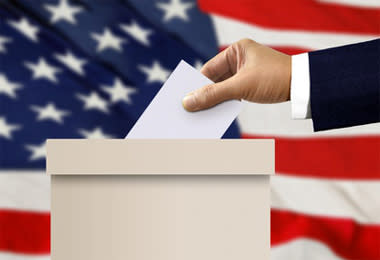How The Election Could Impact ETFs

A blue wave? Gridlock? A November surprise? Investors are trying to wrap their heads around all of the potential outcomes of next month’s highly contentious U.S. elections.
Whoever ends up in charge when the dust settles on Tuesday, Nov. 3 (or after) may affect markets in varying ways.
Here are the potential outcomes and what they could mean for ETFs.
Split Government: Status Quo
While President Trump swept into power on a red wave in 2016, the Republicans lost their majority in the House of Representatives in the 2018 midterm elections. Since then, it’s been gridlock in Washington.
If things remain as they are, or even if the Republicans lose the presidency but retain the Senate, gridlock will prevail.
That means both parties will struggle to pass any sweeping legislation. Big spending packages (including more coronavirus relief), tax cuts/hikes and new health care laws will be difficult to enact.
Wall Street typically cheers gridlock. While some investors may be disappointed by the lack of another large stimulus bill, they may be encouraged by the likelihood that corporate tax rates and capital gains tax rates won’t go up if Republicans hold on to at least the Senate.
While a split government scenario probably means big legislation will struggle to pass both chambers of Congress, who becomes president indeed matters: A continuation of the Trump presidency likely spells more tensions between the U.S. and China, which could weigh on China ETFs; while a Biden presidency could potentially ease some of those tensions.
A Blue Wave
The blue wave scenario is one in which Democrats sweep the election, putting the presidency and the Senate in their camp, while maintaining control of the House.
If that happens, expect many changes to come out of Washington. For one, Democratic presidential nominee Joe Biden has promised to raise the corporate tax rate from 21% to 28%; increase the tax rate on long-term capital gains and qualified dividends to the ordinary income tax rate for incomes above $1 million; put a tax penalty on companies that push manufacturing and services jobs offshore; along with many other tax adjustments.
These changes may lead to lower earnings for most large corporations, all else equal—a negative for stocks. However, the 7% increase in the corporate tax rate might be more easily digested if it’s offset by a hefty stimulus package. The Democrats’ HEROES Act currently sitting in the House of Representatives calls for $3 trillion worth of stimulus spending, or nearly 15% of GDP.
In contrast to the tax hikes elsewhere, if Biden comes to power, he is expected to expand tax credits for renewable energy industries. That goes hand in hand with the Democratic presidential nominee’s plan for $2 trillion worth of spending on infrastructure and clean energy over four years.
Those plans have propelled renewable energy ETFs to strong gains this year, with potentially more to come if the Democrats sweep into power.
Another area where Democrats may make big changes is health care. Biden has pledged to give all Americans a public health insurance option like Medicare. If more Americans are insured, that could push up the demand for health care services and in turn, health care ETFs.
Since the passage of the Affordable Care Act (also known as “Obamacare”) in 2010, which expanded insurance coverage through subsidies and an expansion of Medicaid, the SPDR Health Care Select Sector SPDR Fund (XLV) has outperformed the S&P 500, gaining 302% versus 274%.
An Election Shocker
According to election models, the least likely scenario on Nov. 3 is for the Republicans to end up with control of the House, Senate and presidency. While the party shocked the nation in 2016 by winning across the board on the back of Trump’s unconventional candidacy, the difficulty of pulling off an upset this time has increased.
The economy, while recovering from the worst of the COVID-19-fueled recession, is still in tough shape. That’s an extremely difficult backdrop for the incumbent political party, and one that historically has favored the challenger. Still, nothing is certain, and a November surprise is within the realm of possibilities.
If it happens, expect Republicans to continue their deregulation agenda, which could benefit financial ETFs. The same could be said for traditional energy ETFs, but they face structural head winds that even a unified Republican government will find difficult to offset.
Tensions between the U.S. and China will likely ratchet up further in a second-term Trump administration.
More tax cuts may be difficult to pass even in this scenario, as Republican fiscal hawks balk at a widening deficit. Regardless, taxes will almost certainly stay low if this scenario comes to pass.
Can’t Lose?
Recently, many investors have been suggesting that the election doesn’t matter all that much when it comes to the outlook for stocks. Some sectors and industries will certainly be impacted by the results, but the market as a whole may thrive regardless of the outcome.
That’s because the Federal Reserve has promised to keep interest rates near zero for years into the future, propping up valuations. Moreover, any election scenario has some good news for investors—massive stimulus in the case of a blue wave; lower taxes in the case of a Republican surprise or a split government.
Perhaps these investors are being too complacent. After all, there is always risk in the market. Could a blue wave change the outlook for interest rates? Could a Republican upset bring geopolitical fears to the surface?
These are risks to keep in mind as investors gear up for the election in three weeks.
Email Sumit Roy at sroy@etf.com or follow him on Twitter @sumitroy2
Recommended Stories
